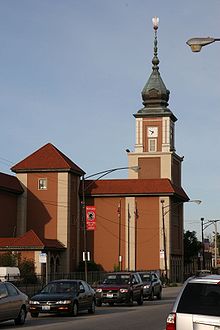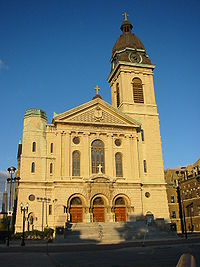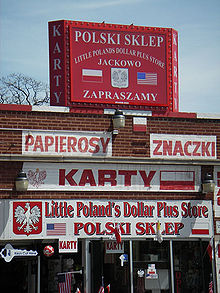- Poles in Chicago
-
 The Gateway Theatre in Jefferson Park is the seat of the Copernicus Foundation. The theater's Baroque spire is a replica of the Royal Castle in Warsaw
The Gateway Theatre in Jefferson Park is the seat of the Copernicus Foundation. The theater's Baroque spire is a replica of the Royal Castle in Warsaw
Chicago Polonia, refers to both immigrant Poles and Americans of Polish heritage living in Chicago, Illinois. They are a part of worldwide Polonia, the proper term for the Polish Diaspora outside of Poland. Poles in Chicago have contributed to the economic, social and cultural well-being of Chicago from its very beginning. Poles have been a part of the history of Chicago since 1837, when Captain John Napieralski, along with other veterans of the November Uprising first set foot there.[1] As of the 2000 U.S. census, Poles in Chicago are the largest European American ethnic group in the city, making up 7.3% of the total population.[2][3] However, according to the 2006–2008 American Community Survey, German Americans and Irish Americans had slightly surpassed Polish Americans as the largest European American ethnic groups in Chicago. German Americans made up 7.3% of the population, and numbered at 199,789; Irish Americans also made up 7.3% of the population, and numbered at 199,294. Polish Americans now made up 6.7% of Chicago's population, and numbered at 182,064.[4] However, Polish Americans are, by far, the largest European American ethnic group in the Chicago metropolitan area, with as many as 1.5 million claiming Polish ancestry.
Contents
History
A number of Poles contributed to the history of the city together with Captain Napieralski, a veteran of Cross Mountain during the November Uprising. Along with him came other early Polish settlers such as Major Louis Chlopicki, the nephew of General Józef Chłopicki who had been the leader of the same insurrection. Not to mention certain A. Panakaske (Panakaski) who resided in the second ward in the 1830s as well as J. Zoliski who lived in the sixth ward with records of both men having cast their ballots for William B. Ogden in the 1837 mayoral race in Chicago.[1]
Distribution
According to Dominic Pacyga, most of the Poles who first came to Chicago settled in five distinct parts of the city.[5] The first of those Polish Patches, as they were colloquially referred to, was located on the Near Northwest Side. Centering on the Polish Triangle at the intersection of Milwaukee and Ashland avenues with Division street it later became known as Polish Downtown. The second large settlement, developed in Pilsen on the west side near 18th street and Ashland avenue. Poles established two separate enclaves in the Stock Yard district, one in Bridgeport, the other in the Back of the Yards near 47th street and Ashland avenue. Another Polish neighborhood developed in the area around the massive Illinois Steel works in South Chicago in the area colloquially referred to as "the Bush". Polish communities in Chicago were often founded and organized around churches mostly by peasant immigrants who named their neighbourhoods after them, like Bronislawowo, named after St. Bronislava.* Sometimes the neighbourhoods are contiguous so its difficult to say precisely where one ends and one begins, as in the case of 'Stanislawowo' by the church of St. Stanislaus Kostka and 'Trojcowo' by Holy Trinity Polish Mission in the former area of Polish Downtown.
- * In Polish the ending 'owo' in e.g., Bronislawowo functions similar to English 'ville' in Johnsville or 'ton' in Charleston. When added to a name of a saint, it indicates a Polish sounding town or a village. This is a colloquial phenomenon, not present in educated Polish; however, it persists in the names of different Polish areas of Chicago.
Original historical Polish patches
St. John Cantius Roman Catholic Church, one of Chicago's 'Polish Cathedrals'.
Polish Downtown
- Trojcowo – The area around Holy Trinity Polish Mission
- Stanislawowo – The area around St. Stanislaus Kostka in Chicago
- Kantowo – The area around St. John Cantius in Chicago
- Mlodziankowo – The area around Holy Innocents in Chicago
- Fidelisowo – The area around St. Fidelis
- Helenowo – The area around St. Helen
- Marianowo – The area around St. Mary of the Angels in Chicago
- Jadwigowo – The area around St. Hedwig's in Chicago
- Wojciechowo – The area around St. Adalbert's in Chicago
- Annowo – The area around St. Anns in Chicago
- Romanowo – The area around St. Roman's
- Kazimierzowo – The area around the former St. Casimir's
- NMP Nieustajacej Pomocy – The area around St. Mary of Perpetual Help
- Barbarowo – The area around St. Barbara in Chicago
Back of the Yards
- Jozefowo – The area around St. Joseph's in Chicago
- Janowo – The area around St. John of God
- Sercanowo – The area around Sacred Heart
South Chicago
- Niepokolanowo – The area around Immaculate Conception in Chicago
- Michalowo – The area around St. Michael's in Chicago
- Magdalenowo – The area around St. Mary Magdalene
- Bronislawowo – The area around St. Bronislava
Subsequent historical Polish patches
Later as Poles grew in number and advanced economically, they migrated further out into outlying areas.[6] The result was that the West Town/Logan Square settlement in Polish Downtown spread westward along North Avenue and northwestward along Milwaukee thereby creating a "Polish Corridor" which tied in contiguous areas such as Norwood Park, Jefferson Park, Portage Park, and Belmont-Cragin.[6] The same kind of advance occurred in the other original areas of Polish settlements so that Poles from both the Lower West Side and the Back of the Yards moved into both sides of Archer Avenue, giving rise to sizable Polish settlements on the Southwest Side of the city such as McKinley Park, Garfield Ridge, Brighton Park and Archer Heights.[6] On the far Southeast Side, the South Chicago "steel mill settlements" spilled over into Pullman, Roseland, East Side, Hegewisch and Calumet City as well as into Lake County in Northwest Indiana, where thriving Polish communities were found in North Hammond, Whiting, the Indian Harbor section of East Chicago and several neighborhoods in the newly built industrial city of Gary.[6]
North Side of Chicago
- Jozafatowo – The area around St. Josaphat's in Chicago which was initially heavily Cassubian
- U Przemienienia – The area around Transfiguration
- Niepokalanego Serca Maryi – The area around Immaculate Heart of Mary
- Wladyslawowo – The area around St. Ladislaus in Chicago
- Konstancowo – The area around St. Constance
- Teklowo – The area around St. Thecla
Belmont Cragin
- Jakubowo – The area around St. James
- U Biskupa (Stanislawowo) – The area around St.Stanislaus, Bishop and Martyr
- U Franciszka – The area around St. Francis of Assisi
South Side of Chicago
- Piotropawlowo – The area around Ss Peter and Paul
- Brunowo – The area around St. Bruno
- Kamilowo – The area around St. Camillus by Midway Airport
- U Pieciu Braci – The area around Five Holy Martyrs
- Pankracowo – The area around St. Pancratius
- U Dobrego Pasterza – The area around Good Shepherd
- Turibiuszowo – The area around St. Turibius
- Salomejowo – The area around St. Salomea
- Florianowo – The area around St.Florian
Over the course of the city's development as the city's Polish community climbed further up the economic ladder and were followed by new waves of immigrants the concentration of Poles shifted to different areas of the city.
The Polish presence in Chicago today
Chicago bills itself as the largest Polish city outside of Poland with approximately 1,100,000 people of Polish ethnicity in the Chicago metropolitan area, although some maintain that after Poland's entry into the EU, London, England is now likely to have more than double this.[7] Chicago's Polish presence is felt in the large number of Polish American organizations located there; including the Polish Museum of America, the Polish American Association, the Polish National Alliance and the Polish Highlanders Alliance of North America. A column fragment of Wawel Castle, the onetime seat of Poland's Royalty has been incorporated into Chicago's landmark Tribune Tower as a visual tribute to Chicago's large Polish populace.
Chicago also has a thriving Polish cultural scene. The city hosts the Polish Film Festival of America where various Polish films are screened during the weeklong festival every October. Polish stage productions in both Polish and English are regularly staged at numerous venues throughout the Chicago Metropolitan Area. The most prominent venues among these are the Chopin and Gateway Theatres. The Gateway, which is also the seat of the Polish Cultural Center in Chicago is the home of the Paderewski Symphony Orchestra. The Lira Ensemble, the only professional performing arts company outside of Poland that specializes in Polish music, song, and dance is Artist-in-Residence at Loyola University Chicago.
Chicago celebrates its Polish Heritage every Labor Day weekend at the Taste of Polonia Festival in Jefferson Park, attended by such political notables as President George H. W. Bush, Dick Cheney, Hadassah Lieberman, Congresswoman Melissa Bean, and Tipper Gore.[8] Illinois is also one of the few states that celebrates Casimir Pulaski Day due to the influence of this large population.
The Almanac of American Politics 2004 states that "Even today, in Archer Heights [a neighborhood of Chicago], you can scarcely go a block without hearing someone speaking Polish".
Poglish
Some of Chicago Polonia (the Polish term for members of the expatriate Polish community) speak Poglish (usually referred to as Chicagowski by local Poles) a fusion of the Polish and English languages. Poglish is a common (to greater or lesser degree, almost unavoidable) phenomenon among persons bilingual in Polish and English, and its avoidance requires considerable effort and attention. Poglish is a manifestation of a broader phenomenon, that of language interference.
The most common phenomenon is the Polonization of English words. Instead of saying (in English), "A cop gave me a ticket on the highway," or (in standard Polish), "Policjant dał mi mandat na autostradzie," a Polonian might say (in Poglish), "Kapy dały mi tiketa na hajłeju." Anyone attempting to speak this kind of Polish-English melange in Poland would have difficulty making himself understood.
See also
- Diaspora politics in the United States
- Felician Sisters
- Polish Cathedral style churches
- Polish Constitution Day Parade
- Polish Falcons
- Polish Roman Catholic Union of America
References
- ^ a b Parot, Joseph, J. "Polish Catholics in Chicago, 1850–1920, Northwestern University Press (1981), p. 19
- ^ Parot, Joseph, J. "Polish Catholics in Chicago, 1850-1920, Northwestern University Press (1981), p. 18
- ^ "Chicago city, Illinois - Profile of Selected Social Characteristics: 2000". American FactFinder. United States Census Bureau. 2000-04-01. http://factfinder.census.gov/servlet/QTTable?_bm=y&-qr_name=DEC_2000_SF3_U_DP2&-ds_name=DEC_2000_SF3_U&-_lang=en&-_sse=on&-geo_id=16000US1714000. Retrieved 23 January 2010.
- ^ http://factfinder.census.gov/servlet/ADPTable?_bm=y&-geo_id=16000US1714000&-qr_name=ACS_2008_3YR_G00_DP3YR2&-ds_name=ACS_2008_3YR_G00_&-_lang=en&-redoLog=false&-_sse=on
- ^ Pacyga, Dominic "Polish Immigrants and Industrial Chicago: Workers on the South Side, 1880–1922" University of Chicago Press, 1991, pp. 41–42
- ^ a b c d Parot, Joseph, J. "Polish Catholics in Chicago, 1850–1920, Northwestern University Press (1981), p. 75
- ^ Paral, Rob (June 2004). "The Polish Community in Metro Chicago: A Community Profile of Strengths and Needs, A Census 2000 Report". RobParal.com. Polish American Association. p. 18. http://www.robparal.com/downloads/Polish%20Community%20in%20Chicago.pdf. Retrieved 23 January 2010.
- ^ America the diverse - Chicago’s Polish neighborhoods (5/15/2005)USA Weekend Magazine.
External links
- Former President of Poland Lech Walesa speaking on the role of Poles in Chicago in the end of communism in Poland
- Polish Localizer Polsort – Polish Businesses and Organizations in Chicago
- Current Polish patches: Polish Masses in Chicago Area provided by Polsort
City of Chicago Chicago metropolitan area · State of Illinois · United States of America Architecture · Beaches · Climate · Colleges and Universities · Community areas · Culture · Demographics · Economy · Flag · Freeways · Geography · Government · History · Landmarks · Literature · Media · Music · Neighborhoods · Parks · Public schools · Skyscrapers · Sports · Theatre · Transportation
 Category ·
Category ·  PortalCategories:
PortalCategories:- Polish American history
- Culture of Chicago, Illinois
- History of Chicago, Illinois
- Chicago Polonia
Wikimedia Foundation. 2010.



